The Impact of Heat Treatment on the Behavior of a Hot-Dip Zinc Coating Applied to Steel During Dry Friction
Abstract
:1. Introduction
2. Materials and Methods
3. Results and Discussion
3.1. Metallographic Observations and Microhardness Distribution
3.2. Friction Coefficient Measurements
3.2.1. The Pin-on-Disc Method
3.2.2. The Schatz Analyse Method
4. Conclusions
- (1)
- With the use of controlled heat treatment of hot-dip zinc coatings, it is possible to successfully reduce the abrasive wear of zinc coatings applied to steel elements and to adjust/change the coefficient of friction according to the operating instructions, within the range of 0.30–0.14.
- (2)
- Microhardness measurements made on the samples subjected to HT in the tested temperature range showed an approximately 3–5 times increase of the HV in the surface layer (145–285 HV 0.02) in relation to the reference samples (58 HV).
- (3)
- After HT (at temperatures below 430 °C), the outside surface of the coating essentially did not change (in either topography or coloring). The groove resulting from friction during the pin-on-disc test was regular. The particles rubbed away from the coating had a "flake" shape and size of 0.1–0.6 mm.
- (4)
- Despite the slight differences seen during macroscopic verification of the tested coatings heat-treated in the temperature range 300–430 °C, with increasing heat treatment temperature, the coating showed higher abrasion resistance, which was manifested by a reduction in weight loss measured during the tribological test.
- (5)
- Heat treatment of zinc coatings at higher temperature (530 °C) caused, besides changes in the microstructure, significant changes in the color of the coating and an essential increase in weight loss due to friction. Additionally, the sheared zinc coating particle shape changed from “flakes” to “fine powder”.
- (6)
- Using the Schatz Analyse system, it was quite easy to evaluate the heat treatment’s influence on the friction coefficient of the zinc coatings in different places on the bolts. Both the µb and µth values were lower after the heat treatment at 530 °C than after the heat treatments at 430 and 300 °C. This knowledge of parameter value is especially important during automatic assembly.
- (7)
- For the proper evaluation of bolt properties, the application of two tests is very useful—the standard pin-on-disk tribometer enables wear mechanism analysis and determination of friction coefficient variability in the cross section of the coating, and the Schatz Analyse system allows technical description of bolt characteristics under realistic conditions.
- (8)
- Considering that the size, geometry, and weight of galvanized elements influence HT’s effects on coatings, the individual selection of treatment conditions (temperature and time) should be preceded by detailed analysis of the heating process.
Author Contributions
Funding
Institutional Review Board Statement
Informed Consent Statement
Data Availability Statement
Conflicts of Interest
References
- International Lead and Zinc Study Group. Lead and Zinc Statistics. Available online: www.ilzsg.org/static/statistics.aspx (accessed on 14 December 2020).
- Maaß, P.; Peißker, P. Handbook of Hot-Dip Galvanization; Wiley-VCH Verlag GmbH & Co. KGaA: Weinheim, Germany, 2011. [Google Scholar]
- Kenhong, T.; Lothongkum, G.; Boonyongmaneerat, Y. Influence of hot-dip coatings on mechanical and corrosion behaviors of steel bolts. J. Met. Mater. Miner. 2014, 24, 49–53. [Google Scholar] [CrossRef]
- Wołczyński, W.; Kucharska, B.; Garzeł, G.; Sypien, A.; Pogoda, Z.; Okane, T. Part III. Kinetics of the (Zn)—Coating Deposition During Stable and Meta-Stable Solidifications. Arch. Met. Mater. 2015, 60, 199–207. [Google Scholar] [CrossRef]
- Marder, A. The metallurgy of zinc-coated steel. Prog. Mater. Sci. 2000, 45, 191–271. [Google Scholar] [CrossRef]
- Massalski, T.B.; Okamoto, H.; Subramanian, P.R.; Kacprzak, L. Binary Alloy Phase Diagrams; ASM International: Novelty, OH, USA, 1990. [Google Scholar]
- Pokorný, P.; Cinert, J.; Pala, Z. Fe-Zn intermetallic phases prepared by diffusion annealing and spark-plasma sintering. Mater. Tehnol. 2016, 50, 253–256. [Google Scholar] [CrossRef]
- Onishi, M.; Wakamatsu, Y.; Miura, H. Formation and Growth Kinetics of Intermediate Phases in Fe–Zn Diffusion Couples. Trans. Jpn. Inst. Met. 1974, 15, 331–337. [Google Scholar] [CrossRef] [Green Version]
- Kopyciński, D. Crystallization of Intermetallic Phases and of Zinc on Iron and Its Low—And High-Carbon Alloys during Galvanizing Process. Ph.D. Thesis, University of Science and Technology Press, Cracow, Poland, 2006. [Google Scholar]
- Kopyciński, D.; Guzik, E.; Wołczyński, W. Coating Zn formation during hot dip galvanizing. Mater. Eng. 2008, 4, 289–292. [Google Scholar]
- Wegrzynkiewicz, S.; Jedrzejczyk, D.; Szłapa, I.; Hajduga, M.; Boczkal, S. Influence of a Substrate Surface on the (Zn)—Coating Formation/Wpływ Powierzchni Podłoża Na Kształtowanie Się Powłoki (Zn). Arch. Met. Mater. 2014, 59, 1373–1378. [Google Scholar] [CrossRef]
- PKN. Standard—Hot-Dip Galvanized Coatings on Fabricated Iron and Steel Articles—Specifications and Test Methods; PN EN ISO 1461:2011; Polish Committee for Standardization: Warsaw, Poland, 2011. [Google Scholar]
- PKN. Standard, Zinc Coatings—Guidelines and Recommendations for the Protection Against Corrosion of Iron and Steel in Structures—Part 2: Hot Dip Galvanizing; PN EN ISO 14713-2:2020; Polish Committee for Standardization: Warsaw, Poland, 2020. [Google Scholar]
- Jedrzejczyk, D.; Hajduga, M. Effect of the Surface Oxidation on the Hot-Dip Zinc Galvanizing of Cast Iron. Arch. Met. Mater. 2011, 56, 839–849. [Google Scholar] [CrossRef] [Green Version]
- Jedrzejczyk, D. Effect of High Temperature Oxidation on Structure and Corrosion Resistance of the Zinc Coating Deposited on Cast Iron. Arch. Met. Mater. 2012, 57, 145–154. [Google Scholar] [CrossRef]
- Vaamonde Vazquez, A.J.; Damborenea, J. The Sandelin effect and continuously cast steel. Int. J. Mater. Prod. Technol. 1991, 6, 175–216. [Google Scholar]
- Che, C.; Lu, J.; Kong, G.; Xu, Q. Role of silicon in steels on galvanized coatings. Acta Met. Sin. Engl. Lett. 2009, 22, 138–145. [Google Scholar] [CrossRef]
- Che, C.; Lu, J.; Kong, G. Interpretation of Sebisty effect of hot dip galvanized steels. Trans. Nonferr. Met. Soc. China 2005, 15, 1275–1279. [Google Scholar]
- Kania, H.; Mendala, J.; Kozuba, J.; Saternus, M. Development of Bath Chemical Composition for Batch Hot-Dip Galvanizing—A Review. Materials 2020, 13, 4168. [Google Scholar] [CrossRef] [PubMed]
- Kania, H.; Liberski, P.P. Synergistic influence of Al, Ni, Bi and Sn addition to a zinc bath upon growth kinetics and the structure of coatings. IOP Conf. Ser. Mater. Sci. Eng. 2012, 35, 012004. [Google Scholar] [CrossRef]
- Kania, H.; Liberski, P. Synergistic Influence of the Addition of Al, Ni and Pb to a Zinc Bath upon Growth Kinetics and Structure of Coatings. Solid State Phenom. 2013, 212, 115–120. [Google Scholar] [CrossRef]
- Pistofidis, N.; Vourlias, G.; Konidaris, S.; Pavlidou, E.; Stergiou, A.; Stergioudis, G. The effect of bismuth on the structure of zinc hot-dip galvanized coatings. Mater. Lett. 2007, 61, 994–997. [Google Scholar] [CrossRef]
- Katiforis, N.; Papadimitriou, G. Influence of copper, cadmium and tin additions in the galvanizing bath on the structure, thickness and cracking behaviour of the galvanized coatings. Surf. Coat. Technol. 1996, 78, 185–195. [Google Scholar] [CrossRef]
- Vourlias, G.; Pistofidis, N.; Stergioudis, G.; Tsipas, D. The effect of alloying elements on the crystallization behaviour and on the properties of galvanized coatings. Cryst. Res. Technol. 2004, 39, 23–29. [Google Scholar] [CrossRef]
- Bicao, P.; Jianhua, W.; Su, X.P.; Zhi, L.; Fucheng, Y. Effects of zinc bath temperature on the coatings of hot-dip galvanizing. Surf. Coat. Technol. 2008, 202, 1785–1788. [Google Scholar] [CrossRef]
- Lekbir, C.; Dahoun, N.; Guetitech, A.; Hacid, A.; Ziouche, A.; Ouaad, K.; Djadoun, A. Effect of Immersion Time and Cooling Mode on the Electrochemical Behavior of Hot-Dip Galvanized Steel in Sulfuric Acid Medium. J. Mater. Eng. Perform. 2017, 26, 2502–2511. [Google Scholar] [CrossRef]
- Bondareva, O.S.; Melnikov, A.A.; Amosov, A. Influence of hot-dip galvanizing temperature on formation of zinc coating on a steel with a high silicon content. Adv. Environ. Biol. 2014, 8, 943–948. [Google Scholar]
- Bondareva, O. Study of the Temperature Effect on the Structure and Thickness of Hot-Dip Zinc Coatings on Fixing Products. Appl. Mech. Mater. 2014, 698, 355–359. [Google Scholar] [CrossRef]
- Gapsari, F.; Setyarini, P.H.; Anam, K.; Azizah, S.; Yuliati, R. The Effect of Hot Dip Galvanizing Temperature to Corrosion Rate of Steel as the Material for Chopper Machine. Solid State Phenom. 2019, 291, 148–154. [Google Scholar] [CrossRef]
- Liberski, P.; Tatarek, A.; Kania, H.; Podolski, P. Coating growth on silicon-containing iron alloys in hot dip galvanizing process. In Proceedings of the 22nd International Galvanizing Conference Intergalva 2009, EGGA, Madrid, Spain, 8–12 June 2009; pp. 181–187. [Google Scholar]
- Evans, D.W. Next generation technology for corrosion protection in ground support. In Proceedings of the 2014 Coal Operators’ Conference, Wollongong, Australia, 12–14 February 2014; pp. 177–185. [Google Scholar]
- Evin, E.; Tomas, M.; Semjon, V. Study of Fe-Zn coated steel sheets tribological characteristics. Tribologia 2013, 1, 35–46. [Google Scholar]
- Sonntag, B.; Thom, K.; Dambrowsky, N.; Dingwerth, B. Zinc-Niciel electroplating—Best Suited. Electrolytes for a diversity of apliccations. Galvanotechnik 2009, 7, 1499–1513. [Google Scholar]
- Fayomi, O.; Popoola, A. An Investigation of the Properties of Zn Coated Mild Steel. Int. J. Electrochem. Sci. 2012, 7, 6555–6570. [Google Scholar]
- Buchtík, M.; Krystýnová, M.; Másilko, J.; Wasserbauer, J. The Effect of Heat Treatment on Properties of Ni–P Coatings Deposited on a AZ91 Magnesium Alloy. Coatings 2019, 9, 461. [Google Scholar] [CrossRef] [Green Version]
- Li, J.; Li, Y.; Tian, X.; Zou, L.; Zhao, X.; Wang, S.; Wang, S. The Hardness and Corrosion Properties of Trivalent Chromium Hard Chromium. Mater. Sci. Appl. 2017, 8, 1014–1026. [Google Scholar] [CrossRef] [Green Version]
- Szabadi, L.; Kalacska, G.; Pek, L.; Palinkas, I. Abrasive wear of different hot-dip galvanized multilayers. Sustain. Constr. Des. 2011, 82–91. [Google Scholar]
- Azadeh, M.; Toroghinejad, M.R. Effect of Heat Treatment on Formability of Hot-dip Galvanized Low Carbon Steel Sheet. ISIJ Int. 2009, 49, 1945–1951. [Google Scholar] [CrossRef] [Green Version]
- Fang, F.; Du, X.F.; Chen, Y.M. Galvanealed coating evolution for hot forming steel. IOP Conf. Ser. Mater. Sci. Eng. 2018, 292, 012101. [Google Scholar] [CrossRef]
- PKN. Standard—Fasteners, Zinc Coatings Applied by Hot-Dip Method; PN EN ISO 10684:2006/Ap1:2013-08; Polish Committee for Standardization: Warsaw, Poland, 2011. [Google Scholar]
- Warcholinski, B.; Kuznetsova, T.; Gilewicz, A.; Zubar, T.I.; Lapitskaya, V.; Chizhik, S.A.; Komarov, A.I.; Komarova, V.I.; Kuprin, A.; Ovcharenko, V.D.; et al. Structural and Mechanical Properties of Zr-Si-N Coatings Deposited by Arc Evaporation at Different Substrate Bias Voltages. J. Mater. Eng. Perform. 2018, 27, 3940–3950. [Google Scholar] [CrossRef] [Green Version]
- Warcholinski, B.; Gilewicz, A.; Kuprin, A.; Tolmachova, G.; Ovcharenko, V.; Kuznetsova, T.; Zubar, T.; Khudoley, A.; Chizhik, S. Mechanical properties of Cr-O-N coatings deposited by cathodic arc evaporation. Vacuum 2018, 156, 97–107. [Google Scholar] [CrossRef]
- Kania, H.; Liberski, P. Kryteria doboru składu chemicznego kąpieli cynkowej. In Proceedings of the 18th Symposium PTC, Międzyzdroje, Poland, 29 May–1 June 2011. [Google Scholar]
- Borawski, A. Common Methods in Analysing the Tribological Properties of Brake Pads and Discs—A Review. Acta Mech. Autom. 2019, 13, 189–199. [Google Scholar] [CrossRef] [Green Version]
- Sriraman, K.; Strauss, H.; Brahimi, S.; Chromik, R.R.; Szpunar, J.; Osborne, J.; Yue, S. Tribological behavior of electrodeposited Zn, Zn–Ni, Cd and Cd–Ti coatings on low carbon steel substrates. Tribol. Int. 2012, 56, 107–120. [Google Scholar] [CrossRef]
- Posmyk, A.; Myalski, J. The influence of using conditions on tribological properties of brake systems with composite disc. Tribologia 2019, 2, 117–124. [Google Scholar] [CrossRef]
- Pokorny, P.; Kolisko, J.; Balik, L.; Novak, P. Reaction kinetics of the formation of intermetallic Fe-Zn during hot-dip galvanizing of steel. Metalurgija 2016, 55, 111–114. [Google Scholar]
- Porter, F.C. Zinc Handbook: Properties, Processing, and Use in Design; CRC Press: New York, NY, USA, 1991. [Google Scholar]

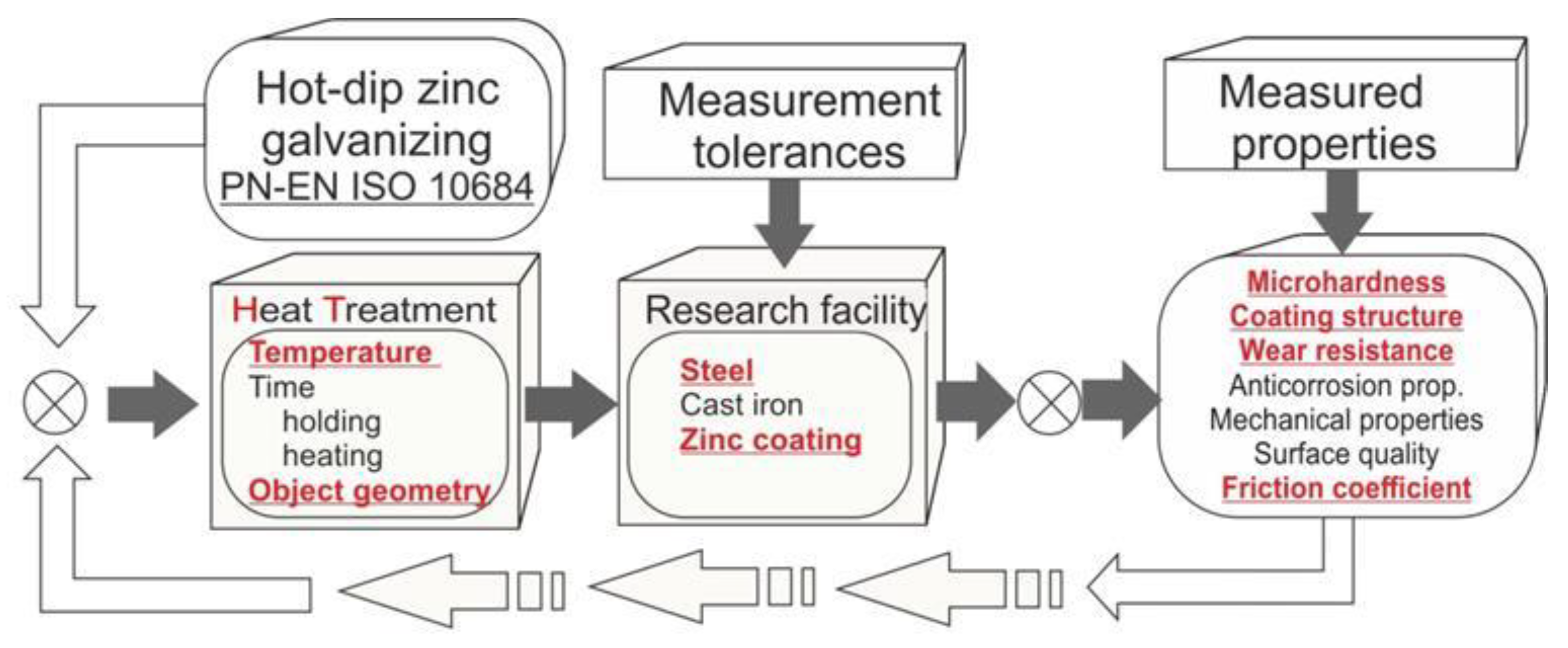
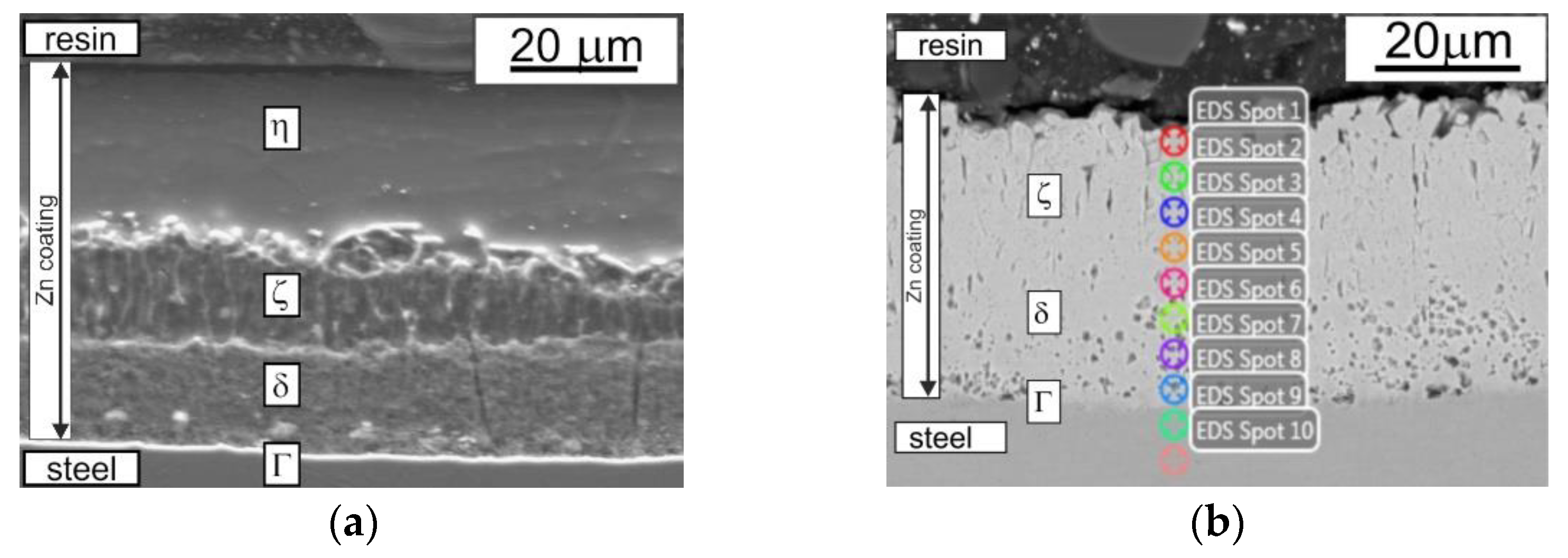
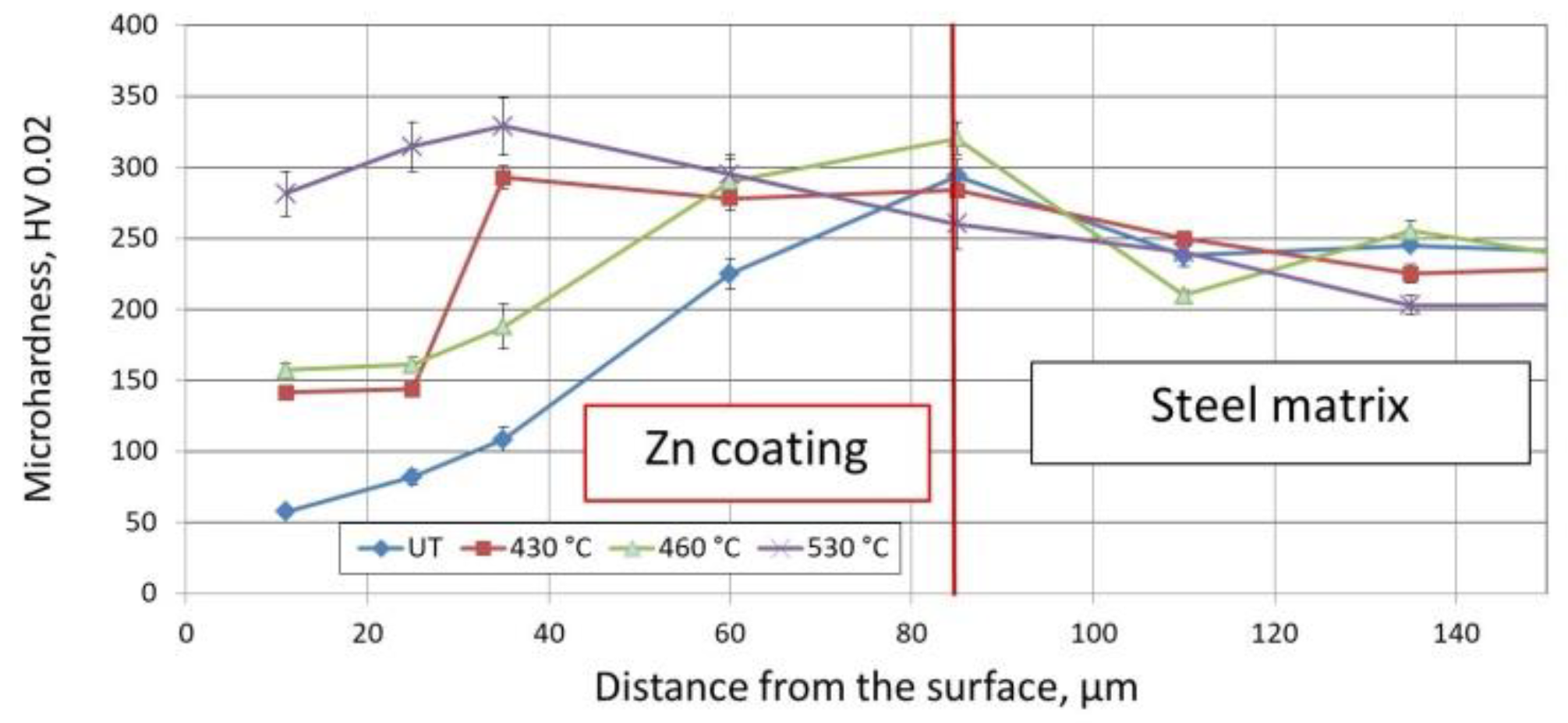
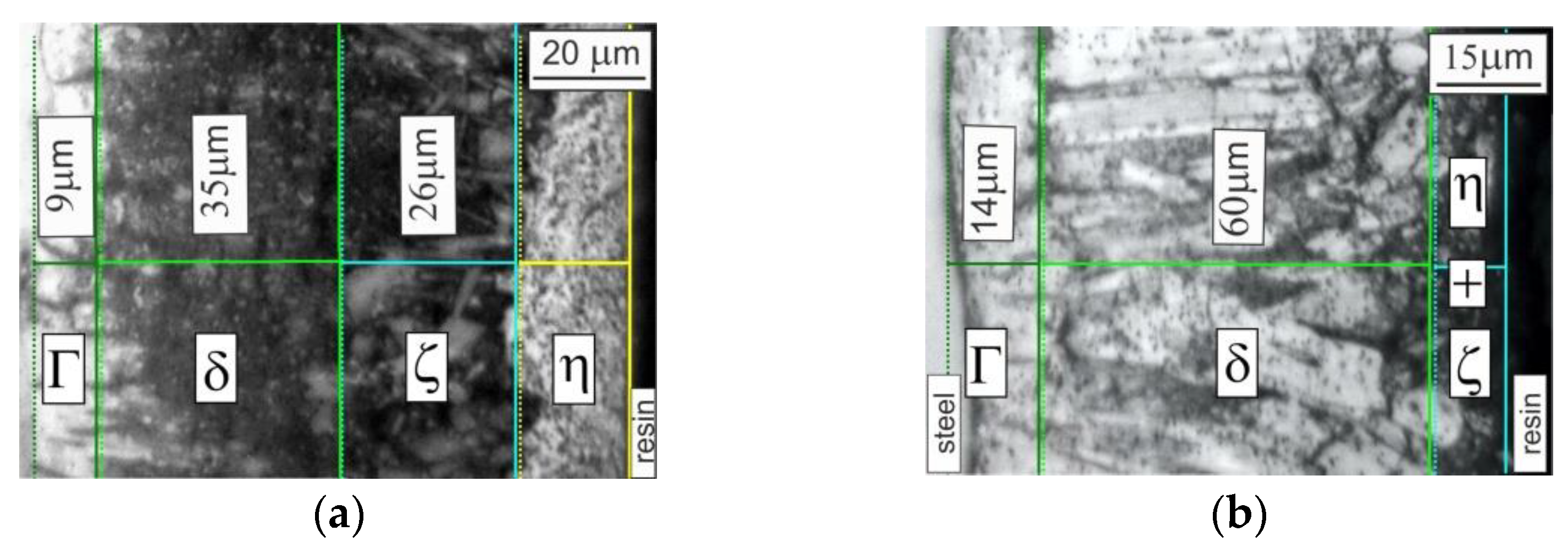
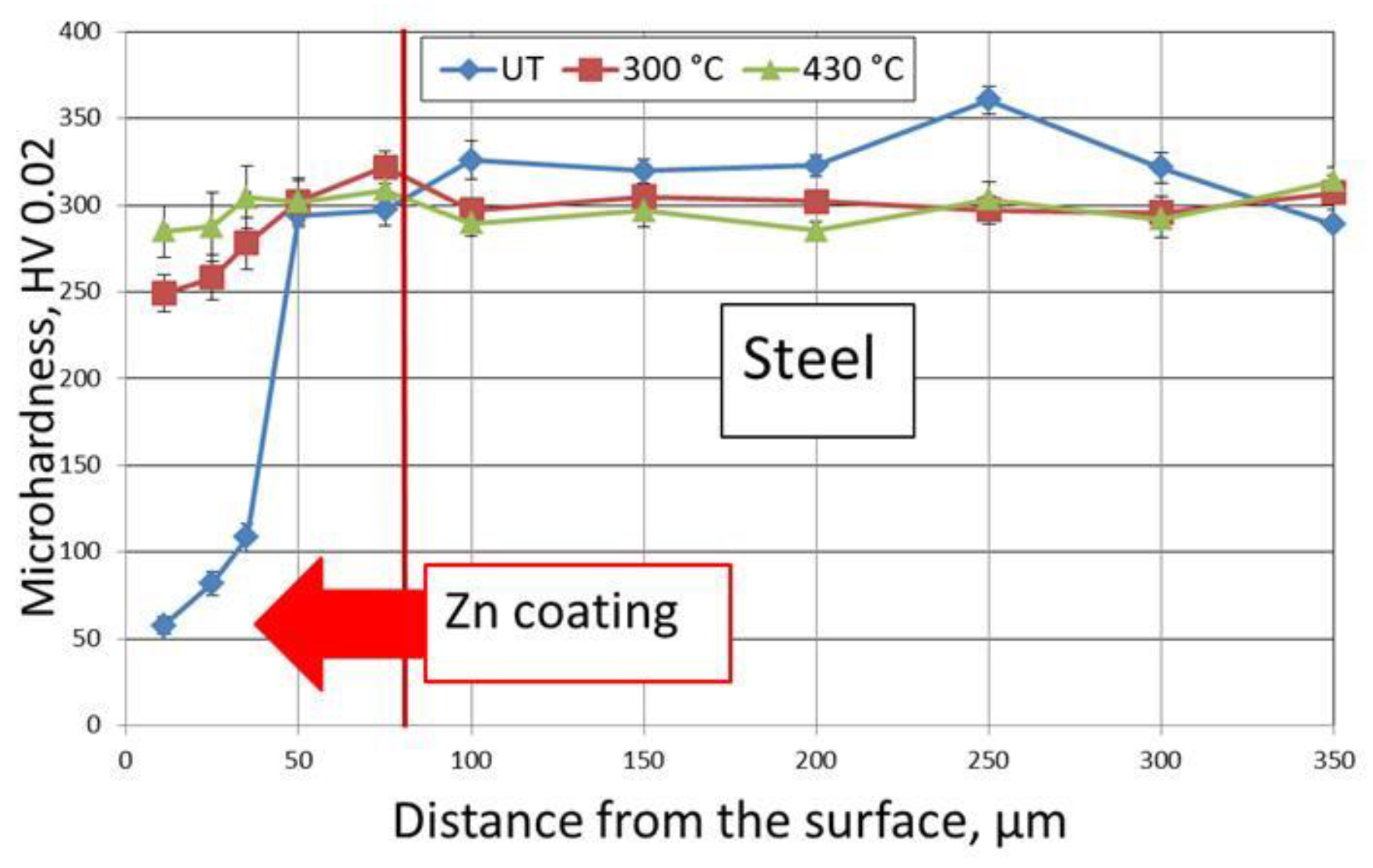
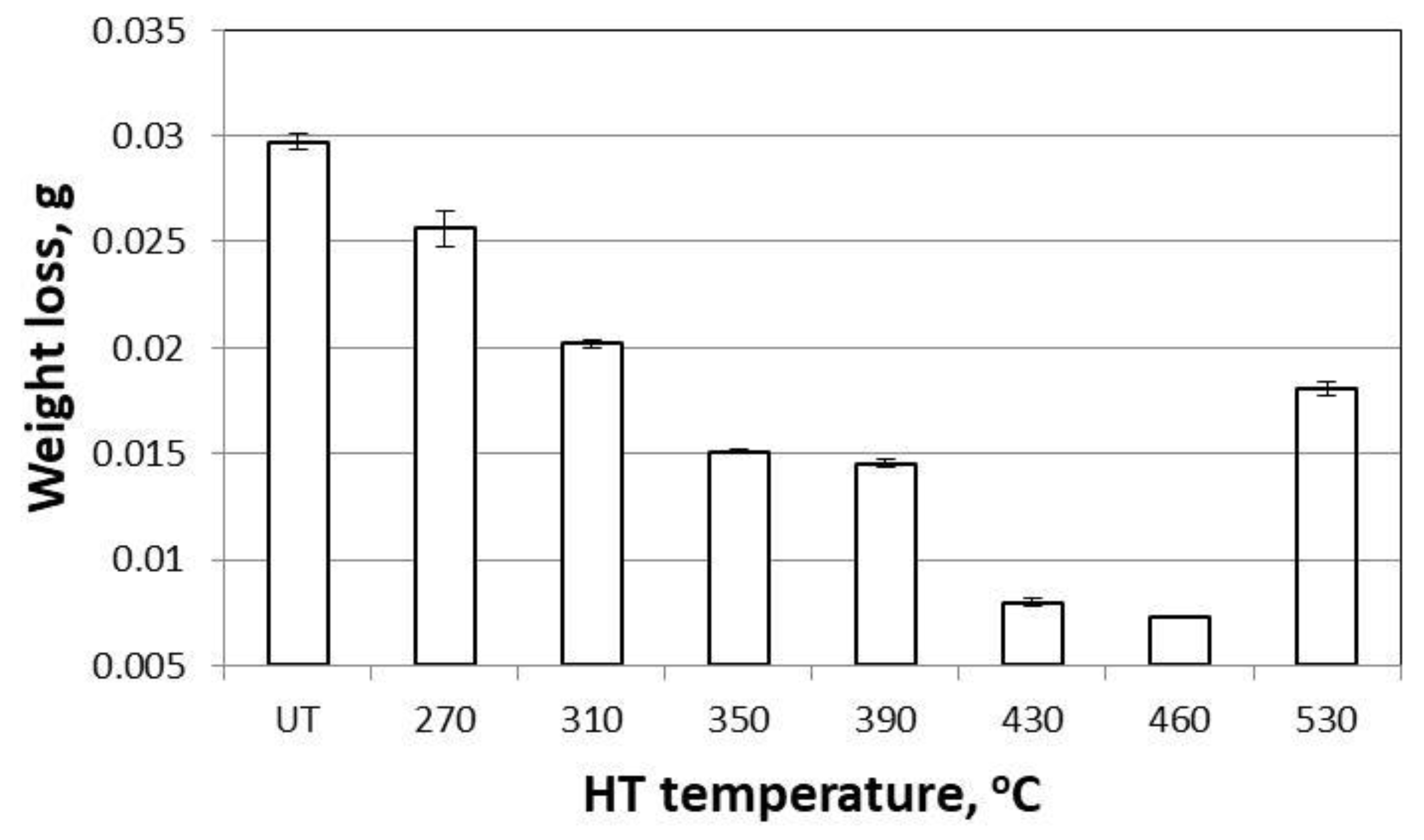

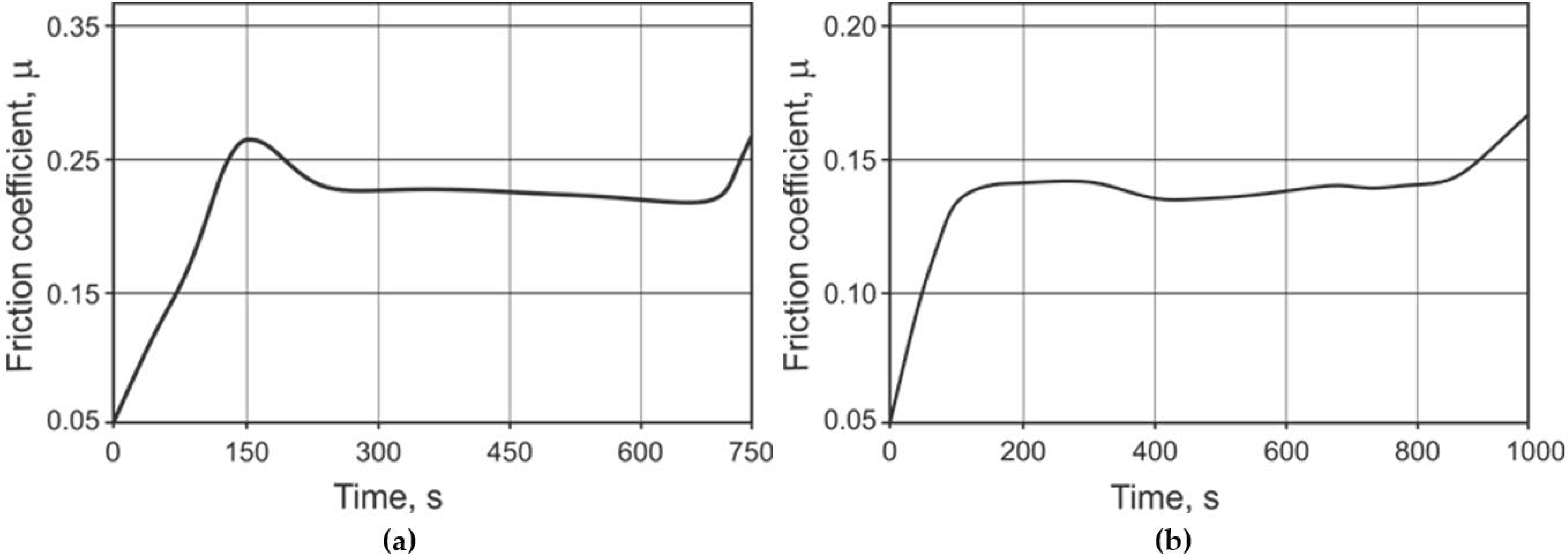
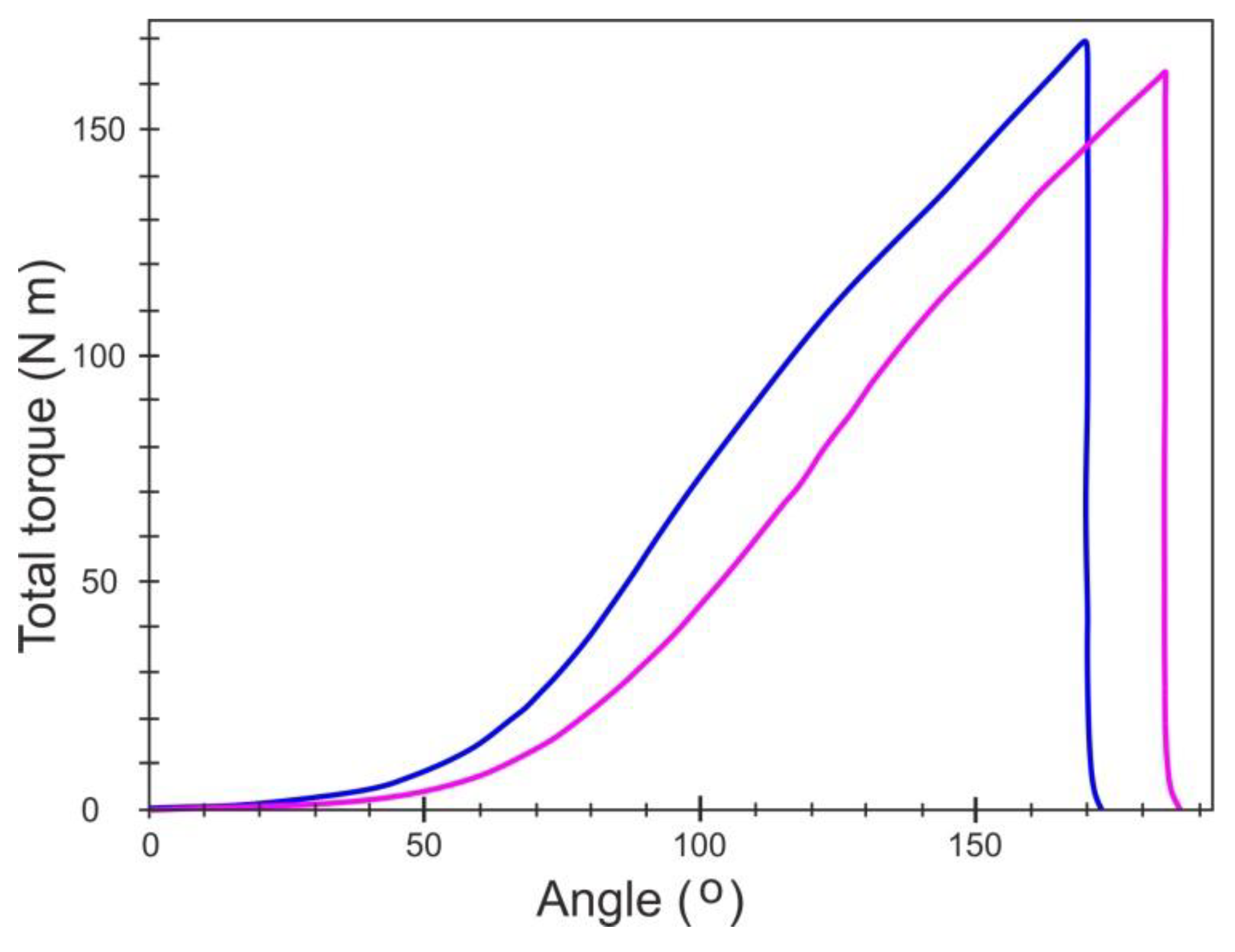
| Element | Distance from the Coating Surface, µm | |||||||
|---|---|---|---|---|---|---|---|---|
| 5 | 15 | 25 | 30 | 40 | 50 | 60 | 70 | |
| Content of the Element, wt% | ||||||||
| Fe | 6.18 | 6.47 | 6.80 | 7.28 | 7.95 | 8.48 | 12.71 | 25.56 |
| Zn | 93.00 | 92.90 | 92.36 | 91.96 | 91.31 | 90.65 | 86.47 | 73.39 |
| O | 0.82 | 0.63 | 0.84 | 0.76 | 0.74 | 0.87 | 0.82 | 1.05 |
| Sample No. | F (kN) | T (N m) | Tb (N m) | Tth (N m) | µb | µth | µtot |
|---|---|---|---|---|---|---|---|
| 0.1 | 36.69 | 153.63 | 79.67 | 73.96 | 0.28 | 0.28 | 0.28 |
| 0.2 | 36.68 | 158.26 | 81.29 | 76.98 | 0.28 | 0.29 | 0.29 |
| 0 average | 36.69 | 155.95 | 80.48 | 75.47 | 0.28 | 0.29 | 0.29 |
| 1.1 | 36.69 | 169.54 | 122.93 | 46.61 | 0.43 | 0.16 | 0.31 |
| 1.2 | 36.70 | 161.57 | 102.12 | 59.45 | 0.36 | 0.21 | 0.29 |
| 1 average | 36.69 | 165.55 | 112.52 | 53.03 | 0.39 | 0.19 | 0.30 |
| 2.1 | 36.69 | 130.87 | 78.31 | 52.56 | 0.27 | 0.18 | 0.23 |
| 2.2 | 36.69 | 139.53 | 91.78 | 47.74 | 0.32 | 0.16 | 0.25 |
| 2 average | 36.69 | 135.20 | 85.05 | 50.15 | 0.30 | 0.17 | 0.24 |
| 3.1 | 36.69 | 79.54 | 35.40 | 44.14 | 0.12 | 0.15 | 0.13 |
| 3.2 | 36.68 | 84.90 | 37.20 | 47.69 | 0.13 | 0.16 | 0.15 |
| 3 average | 36.68 | 82.22 | 36.30 | 45.92 | 0.12 | 0.15 | 0.14 |
Publisher’s Note: MDPI stays neutral with regard to jurisdictional claims in published maps and institutional affiliations. |
© 2021 by the authors. Licensee MDPI, Basel, Switzerland. This article is an open access article distributed under the terms and conditions of the Creative Commons Attribution (CC BY) license (http://creativecommons.org/licenses/by/4.0/).
Share and Cite
Jędrzejczyk, D.; Szatkowska, E. The Impact of Heat Treatment on the Behavior of a Hot-Dip Zinc Coating Applied to Steel During Dry Friction. Materials 2021, 14, 660. https://doi.org/10.3390/ma14030660
Jędrzejczyk D, Szatkowska E. The Impact of Heat Treatment on the Behavior of a Hot-Dip Zinc Coating Applied to Steel During Dry Friction. Materials. 2021; 14(3):660. https://doi.org/10.3390/ma14030660
Chicago/Turabian StyleJędrzejczyk, Dariusz, and Elżbieta Szatkowska. 2021. "The Impact of Heat Treatment on the Behavior of a Hot-Dip Zinc Coating Applied to Steel During Dry Friction" Materials 14, no. 3: 660. https://doi.org/10.3390/ma14030660
APA StyleJędrzejczyk, D., & Szatkowska, E. (2021). The Impact of Heat Treatment on the Behavior of a Hot-Dip Zinc Coating Applied to Steel During Dry Friction. Materials, 14(3), 660. https://doi.org/10.3390/ma14030660







